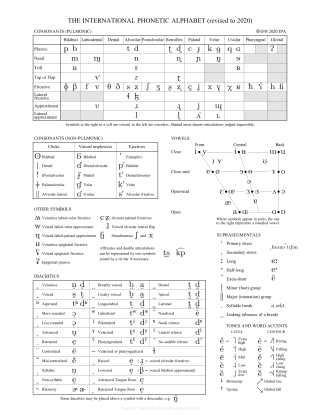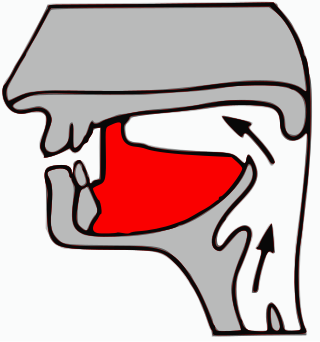Approximants are speech sounds that involve the articulators approaching each other but not narrowly enough nor with enough articulatory precision to create turbulent airflow. Therefore, approximants fall between fricatives, which do produce a turbulent airstream, and vowels, which produce no turbulence. This class is composed of sounds like and semivowels like and, as well as lateral approximants like.
A fricative is a consonant produced by forcing air through a narrow channel made by placing two articulators close together. These may be the lower lip against the upper teeth, in the case of ; the back of the tongue against the soft palate in the case of German ; or the side of the tongue against the molars, in the case of Welsh. This turbulent airflow is called frication.

The International Phonetic Alphabet (IPA) is an alphabetic system of phonetic notation based primarily on the Latin script. It was devised by the International Phonetic Association in the late 19th century as a standard written representation for the sounds of speech. The IPA is used by lexicographers, foreign language students and teachers, linguists, speech–language pathologists, singers, actors, constructed language creators, and translators.
In linguistics, a liquid consonant or simply liquid is any of a class of consonants that consists of rhotics and voiced lateral approximants, which are also sometimes described as "R-like sounds" and "L-like sounds". The word liquid seems to be a calque of the Ancient Greek word ὑγρός, initially used by grammarian Dionysius Thrax to describe Greek sonorants.

In articulatory phonetics, the manner of articulation is the configuration and interaction of the articulators when making a speech sound. One parameter of manner is stricture, that is, how closely the speech organs approach one another. Others include those involved in the r-like sounds, and the sibilancy of fricatives.
In phonetics, rhotic consonants, or "R-like" sounds, are liquid consonants that are traditionally represented orthographically by symbols derived from the Greek letter rho, including ⟨R⟩, ⟨r⟩ in the Latin script and ⟨Р⟩, ⟨p⟩ in the Cyrillic script. They are transcribed in the International Phonetic Alphabet by upper- or lower-case variants of Roman ⟨R⟩, ⟨r⟩: ⟨r⟩, ⟨ɾ⟩, ⟨ɹ⟩, ⟨ɻ⟩, ⟨ʀ⟩, ⟨ʁ⟩, ⟨ɽ⟩, and ⟨ɺ⟩. Transcriptions for vocalic or semivocalic realisations of underlying rhotics include the ⟨ə̯⟩ and ⟨ɐ̯⟩.
In phonetics, a plosive, also known as an occlusive or simply a stop, is a pulmonic consonant in which the vocal tract is blocked so that all airflow ceases.
A vowel is a syllabic speech sound pronounced without any stricture in the vocal tract. Vowels are one of the two principal classes of speech sounds, the other being the consonant. Vowels vary in quality, in loudness and also in quantity (length). They are usually voiced and are closely involved in prosodic variation such as tone, intonation and stress.
Velars are consonants articulated with the back part of the tongue against the soft palate, the back part of the roof of the mouth.
Labial consonants are consonants in which one or both lips are the active articulator. The two common labial articulations are bilabials, articulated using both lips, and labiodentals, articulated with the lower lip against the upper teeth, both of which are present in English. A third labial articulation is dentolabials, articulated with the upper lip against the lower teeth, normally only found in pathological speech. Generally precluded are linguolabials, in which the tip of the tongue contacts the posterior side of the upper lip, making them coronals, though sometimes, they behave as labial consonants.
In phonetics and phonology, a semivowel, glide or semiconsonant is a sound that is phonetically similar to a vowel sound but functions as the syllable boundary, rather than as the nucleus of a syllable. Examples of semivowels in English are the consonants y and w in yes and west, respectively. Written in IPA, y and w are near to the vowels ee and oo in seen and moon, written in IPA. The term glide may alternatively refer to any type of transitional sound, not necessarily a semivowel.
Uvulars are consonants articulated with the back of the tongue against or near the uvula, that is, further back in the mouth than velar consonants. Uvulars may be stops, fricatives, nasals, trills, or approximants, though the IPA does not provide a separate symbol for the approximant, and the symbol for the voiced fricative is used instead. Uvular affricates can certainly be made but are rare: they occur in some southern High-German dialects, as well as in a few African and Native American languages. Uvular consonants are typically incompatible with advanced tongue root, and they often cause retraction of neighboring vowels.
A labialized velar or labiovelar is a velar consonant that is labialized, with a -like secondary articulation. Examples are, which are pronounced like a, with rounded lips, such as the labialized voiceless velar plosive and labialized voiced velar plosive, obstruents being common among the sounds that undergo labialization.

A retroflex, apico-domal, or cacuminalconsonant is a coronal consonant where the tongue has a flat, concave, or even curled shape, and is articulated between the alveolar ridge and the hard palate. They are sometimes referred to as cerebral consonants—especially in Indology.

The voiced labiodental nasal is a type of consonantal sound. The symbol in the International Phonetic Alphabet that represents this sound is ⟨ɱ⟩. The IPA symbol is a lowercase letter m with a leftward hook protruding from the lower right of the letter. Occasionally it is instead transcribed as an with a dental diacritic: ⟨m̪⟩.
In phonetics, nasalization is the production of a sound while the velum is lowered, so that some air escapes through the nose during the production of the sound by the mouth. An archetypal nasal sound is.
In phonetics and phonology, a sonorant or resonant is a speech sound that is produced with continuous, non-turbulent airflow in the vocal tract; these are the manners of articulation that are most often voiced in the world's languages. Vowels are sonorants, as are semivowels like and, nasal consonants like and, and liquid consonants like and. This set of sounds contrasts with the obstruents.
The phonology of Italian describes the sound system—the phonology and phonetics—of standard Italian and its geographical variants.
The phonology of Sesotho and those of the other Sotho–Tswana languages are radically different from those of "older" or more "stereotypical" Bantu languages. Modern Sesotho in particular has very mixed origins inheriting many words and idioms from non-Sotho–Tswana languages.
This article discusses the phonology of the Inuit languages. Unless otherwise noted, statements refer to Inuktitut dialects of Canada.




